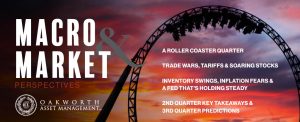- With illegal border crossings decreasing and self-deportation on the rise, the U.S. economy could eventually see an overall decrease in consumer demand — either from fewer people consuming goods or lower-than-expected population growth. Obviously, this could have a negative impact on the Gross Domestic Product (GDP) equation.
- The administration’s tariffs may not be as inflationary as many fear. In a potential worst-case scenario, Americans may spend more on essentials, leaving less money to spend on everything else. As such, unless there is a sudden increase in the money supply, decreased consumer demand for ‘elastic’ goods and services may largely offset any price increases on essentials.
- Due to a variety of factors, the inventory of existing homes for sale may continue to This could cause the supply of homes to potentially increase faster than the demand for them at current levels. As a result, home prices could start to fall by the end of the year. While it might not be a dramatic decrease in prices, any little bit will likely help potential home buyers.
- The Federal Reserve may start to cut the target overnight lending rate during the 3rd quarter. By then, the Fed may have enough economic data to support being more aggressive in cutting the rate — should it so desire. Will it?
- As the New York mayoral campaign heats up, mainstream Democrats may push for a more moderate candidate to run as an independent against Zohran Mamdani. This race is poised to draw national attention and could signal how far left the Democratic Party is willing to go ahead of the 2026 and 2028 elections.
- Although the U.S. administration has declared an end to the 12-Day War between Israel and Iran, the two warring sides might not completely get the message. As long as Iran remains a theocracy, the risk of renewed escalation may be far greater than the prospect of a lasting peace.
- Anti-ICE protests may likely continue, but with decreasing frequency and severity. The reason is simple: suburbanites, college students and professional protestors may move onto other issues once it becomes apparent the administration is serious and consistent about enforcing current immigration policy.
- The splash around the DOGE initiative will likely be a distant memory by the end of the The politicians in Washington may not have the stomach to make the spending cuts necessary to have a meaningful impact on the budget deficit. Of course, this may mean even more debt, which creates the potential for higher interest rates in the future.
- While it is difficult to predict whether gold will continue its recent surge, the conditions that make precious metals attractive will likely remain. These conditions being: excessive debt, bloated bank balance sheets and declining investor confidence in public institutions.
- Market bears have been waiting for the proverbial shoe to drop for a long time. This go-around, the logical suspect is likely crude oil. Should there be a significant supply shock to push WTI crude oil futures above $80/ barrel, we could see domestic investor psyche change quickly and dramatically.
- Europe may struggle with the tough realization that it lacks the hard and soft power it once believed it had. To regain influence, it may have to dramatically increase its military capabilities or unfetter its private sector — preferably both. Unfortunately, it will likely struggle to do either effectively.
- By the end of 2025, it will become increasingly apparent that China is no longer a one-man show. While Xi Jinping is not likely in danger of losing power, other names in Beijing could start to get far more ink on a global scale, notably Premier Li Qiang.
- In an effort to reverse falling sales, mainline beer producers may do something drastic — slashing prices on weak, mass-market American-style Pilsners. A 12- pack of the watery stuff seems too expensive for the target market, and the manufacturers appear to have been slow to realize it.
This content is part of our quarterly outlook and overview. For more of our view on this quarter’s economic overview, inflation, bonds, equities and allocations, read the latest issue of Macro & Market Perspectives.
Advisory Services, including investment management and financial planning, are offered through Oakworth Asset Management LLC a registered investment advisor and is owned by Oakworth Capital Bank, Member FDIC. Investment products and services offered via Oakworth Asset Management LLC are independent of the products and services offered by Oakworth Capital Bank, and are not FDIC insured, may lose value, have no bank guarantee, and are not insured by any federal or state government agency. Because of the ownership relationship and involvement by Oakworth Asset Management LLC associates with Oakworth Capital Bank, there exists a conflict of interest to the extent that either party recommends the services of the other. Oakworth Asset Management LLC does not provide tax or legal advice. You should consult your tax advisor, accountant, and/or attorney before making any decisions with tax or legal implications. For additional information about Oakworth Asset Management LLC, including its services and fees, send for the firm’s disclosure brochure using the contact information contained herein or visit advisorinfo.sec.gov.
This communication contains general information that is not suitable for everyone and was prepared for informational purposes only Nothing contained herein should be construed as a solicitation to buy or sell any security or as an offer to provide investment advice. The information contained herein is based upon certain assumptions, theories and principles that do not completely or accurately reflect
any one client situation. This communication contains certain forward-looking statements that indicate future possibilities. Due to known and unknown risks, other uncertainties and factors, actual results may differ. As such, there is no guarantee that any views and opinions expressed herein will come to pass. Investing involves risk of loss including loss of principal. Past investment performance is not a guarantee or predictor of future investment performance.
Any reference to a market index is included for illustrative purposes only as it is not possible to directly invest in an index. The figures for each index reflect the reinvestment of dividends, as applicable, but do not reflect the deduction of any fees or expenses, the incurrence of which would reduce returns. It should not be assumed that your account performance or the volatility of any securities held in your account will correspond directly to any comparative benchmark index. This communication contains information derived from third party sources. Although we believe these sources to be reliable, we make no representations as to their accuracy or completeness.
All opinions and/or views reflect the judgment of the authors as of the publication date and are subject to change without notice.



